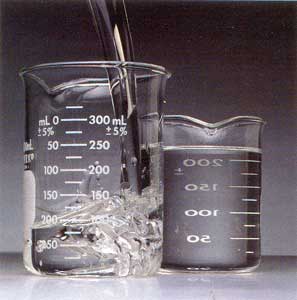heat-transfer fluid

A heat-transfer fluid is a gas or liquid used to move heat energy from one place to another. Refrigerants are well-known examples of heat-transfer fluids.
Heat-transfer fluids for solar water heating systems
Heat-transfer fluids carry heat through solar collectors and a heat exchanger to the heat storage tanks in solar water heating systems. When selecting a heat-transfer fluid, you and your solar heating contractor should consider the following criteria:
For example, in a cold climate, solar water heating systems require fluids with low freezing points. Fluids exposed to high temperatures, as in a desert climate, should have a high boiling point. Viscosity and thermal capacity determine the amount of pumping energy required. A fluid with low viscosity and high specific heat is easier to pump, because it is less resistant to flow and transfers more heat. Other properties that help determine the effectiveness of a fluid are its corrosiveness and stability.
Types of heat-transfer fluids
The following are some of the most commonly used heat-transfer fluids and their properties:
Air will not freeze or boil, and is non-corrosive. However, it has a very low heat capacity, and tends to leak out of collectors, ducts, and dampers.
Water is nontoxic and inexpensive. With a high specific heat, and a very low viscosity, it's easy to pump. Unfortunately, water has a relatively low boiling point and a high freezing point. It can also be corrosive if the pH (acidity/alkalinity level) is not maintained at a neutral level. Water with a high mineral content (i.e., "hard" water) can cause mineral deposits to form in collector tubing and system plumbing.
Glycol/water mixtures have a 50/50 or 60/40 glycol-to-water ratio. Ethylene and propylene glycol are "antifreezes." Ethylene glycol is extremely toxic and should only be used in a double-walled, closed-loop system. You can use food-grade propylene glycol/water mixtures in a single-walled heat exchanger, as long as the mixture has been certified as nontoxic. Make sure that no toxic dyes or inhibitors have been added to it. Most glycols deteriorate at very high temperatures. You must check the pH value, freezing point, and concentration of inhibitors annually to determine whether the mixture needs any adjustments or replacements to maintain its stability and effectiveness.
Hydrocarbon oils have a higher viscosity and lower specific heat than water. They require more energy to pump. These oils are relatively inexpensive and have a low freezing point. The basic categories of hydrocarbon oils are synthetic hydrocarbons, paraffin hydrocarbons, and aromatic refined mineral oils. Synthetic hydrocarbons are relatively nontoxic and require little maintenance. Paraffin hydrocarbons have a wider temperature range between freezing and boiling points than water, but they are toxic and require a double-walled, closed-loop heat exchanger. Aromatic oils are the least viscous of the hydrocarbon oils.
These are commonly used as the heat transfer fluid in refrigerators, air conditioners, and heat pumps. They generally have a low boiling point and a high heat capacity. This enables a small amount of the refrigerant to transfer a large amount of heat very efficiently. Refrigerants respond quickly to solar heat, making them more effective on cloudy days than other transfer fluids. Heat absorption occurs when the refrigerant boils (changes phase from liquid to gas) in the solar collector. Release of the collected heat takes place when the now-gaseous refrigerant condenses to a liquid again in a heat exchanger or condenser. For years chlorofluorocarbon (CFC) refrigerants, such as Freon, were the primary fluids used by refrigerator, air-conditioner, and heat pump manufacturers because they are nonflammable, low in toxicity, stable, noncorrosive, and do not freeze. However, due the negative effect that CFCs have on the earth's ozone layer, CFC production is being phased out, as is the production of hydrochlorofluorocarbons (HCFC). The few companies that produced refrigerant-charged solar systems have either stopped manufacturing the systems entirely, or are currently seeking alternative refrigerants. Some companies have investigated methyl alcohol as a replacement for refrigerants. If you currently own a refrigerant-charged solar system and it needs servicing, you should contact your local solar or refrigeration service professional. Since July 1, 1992, intentional venting of CFCs and HCFCs during service and maintenance or disposal of the equipment containing these compounds is illegal and punishable by stiff fines. Although production of CFCs ceased in the U.S. 1996, a licensed refrigeration technician can still service your system. You may wish to contact your service professional to discuss the possible replacement of the CFC refrigerant with methyl alcohol or some other heat transfer fluid.
Ammonia can also be used as a refrigerant. It's commonly used in industrial applications. Due to safety considerations it's not used in residential systems. The refrigerants can be aqueous ammonia or a calcium chloride ammonia mixture.
Silicones have a very low freezing point, and a very high boiling point. They are noncorrosive and long-lasting. Because silicones have a high viscosity and low heat capacities, they require more energy to pump. Silicones also leak easily, even through microscopic holes in a solar loop.
See solar water heating system freeze protection for more information about liquid heat-transfer fluids.
For more information about residential solar water heating systems, see:
